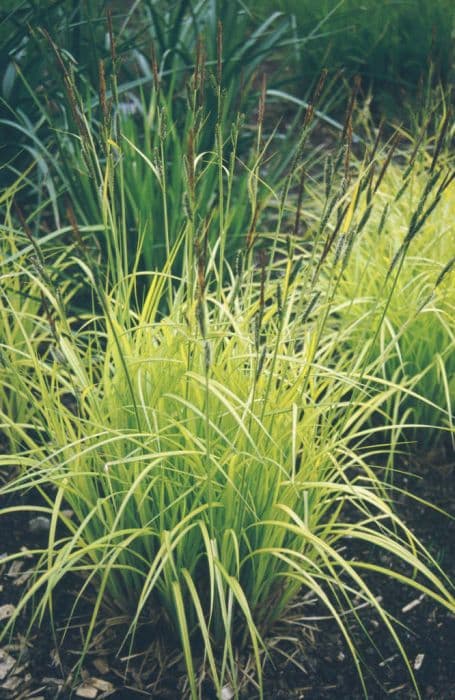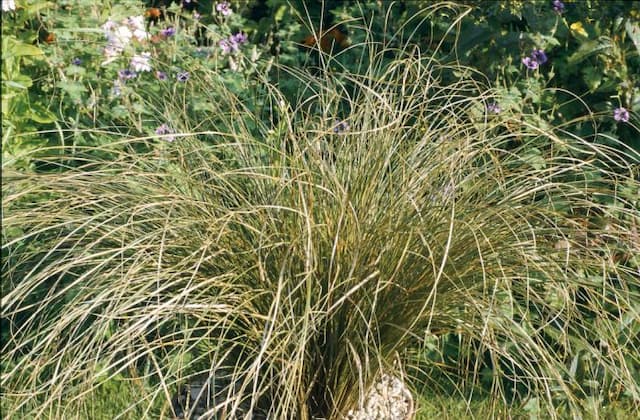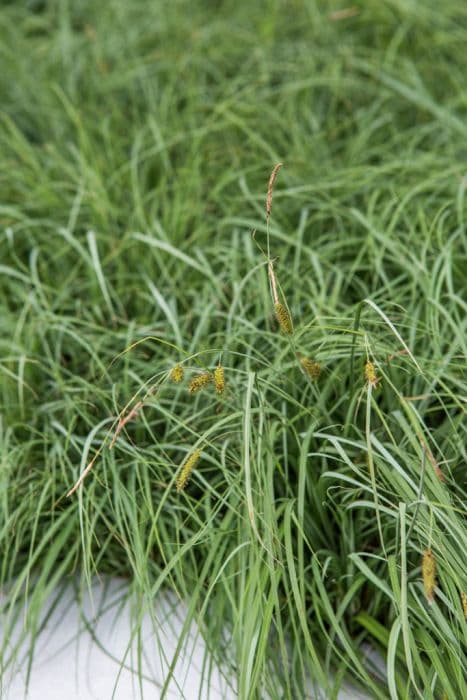Orange New Zealand Sedge Carex testacea

ABOUT
Carex testacea, commonly known as the orange sedge, showcases a distinctive foliage coloration that is its most striking feature. Its leaves exhibit a fine texture, gracefully arching with a blend of olive green and orange hues that intensify with exposure to sunlight. The interplay of colors creates a radiant effect, especially when backlit by the morning or late afternoon sun. Throughout the seasons, the coloration varies, often becoming richer and more vibrant in the cooler months. The orange sedge forms a dense, tussock-like clump and has a fountain-like habit, with its leaves cascading down from the center of the plant. The grass-like leaves are narrow and have a slightly rough texture to the touch. Small, inconspicuous flowers may appear on the plant but are typically overshadowed by the striking foliage. The overall visual effect of the orange sedge is one of warmth and texture, making it a popular choice for adding year-round interest to garden landscapes.
About this plant
 Names
NamesSynonyms
Orange Sedge, Orange New Zealand Sedge, Olive Sedge, Leatherleaf Sedge
Common names
Uncinia testacea, Carex virgata var. testacea
 Toxicity
ToxicityTo humans
Orange New Zealand Sedge (Carex testacea) is not commonly known to be toxic to humans. However, it's always advisable to avoid ingesting plants that are not specifically meant for consumption, as individual reactions can vary. If any part of the plant were ingested and symptoms did appear, it would be wise to consult a healthcare professional.
To pets
Orange New Zealand Sedge (Carex testacea) is also not commonly known to be toxic to pets. As with humans, it is generally recommended to prevent pets from ingesting plants not intended for consumption. There should be no significant risk of poisoning from this plant, but if your pet displays unusual symptoms after ingesting any part of it, contacting a veterinarian would be prudent.
 Characteristics
CharacteristicsLife cycle
Perennials
Foliage type
Evergreen
Color of leaves
Olive-green
Flower color
Brownish
Height
1-2 feet (30-60 cm)
Spread
1-2 feet (30-60 cm)
Plant type
Herb
Hardiness zones
6
Native area
New Zealand
Benefits
 General Benefits
General Benefits- Ornamental Appeal: Offers year-round interest with its striking orange to olive green foliage, providing color contrast in the garden landscape.
- Low Maintenance: Once established, it requires minimal care, making it a hassle-free choice for busy gardeners.
- Drought Tolerance: Can withstand periods of dryness once established, reducing the need for frequent watering.
- Erosion Control: Its fibrous root system helps stabilize soil and prevent erosion on slopes or banks.
- Habitat Support: Provides cover and nesting material for birds, while its seeds can be a food source for wildlife.
- Tolerance of Conditions: Adapts to a wide range of soil types and environmental conditions, making it versatile for various garden settings.
- Textural Contrast: The fine texture of its foliage contrasts well with plants that have broader leaves, enhancing garden design.
- Seasonal Interest: Features subtle flower spikes in summer and warm foliage color transitions in fall, adding seasonal dynamics to the garden.
- Ground Cover: Dense growth habit can help suppress weeds, reducing the need for chemical herbicides.
- Seaside Suitability: Shows a good degree of salt tolerance, making it suitable for coastal gardens prone to sea spray.
 Medical Properties
Medical PropertiesThis plant is not used for medical purposes.
 Air-purifying Qualities
Air-purifying QualitiesThis plant is not specifically known for air purifying qualities.
 Other Uses
Other Uses- Carex testacea, commonly known as Orange New Zealand Sedge, can be used as a natural dye source for fabrics, providing subtle earthy tones due to its natural pigmentation.
- The dry, straw-colored foliage of Orange New Zealand Sedge can be harvested and used for creating eco-friendly packaging material as a sustainable alternative to plastics.
- It serves as an ideal plant for erosion control on slopes or banks due to its dense root system, which helps to stabilize soil.
- The plant can be incorporated into living walls or vertical gardens for unique textural contrast and a pop of color amid other greenery.
- Orange New Zealand Sedge can be utilized in the art of topiary, where its flexible stems and lush texture can help fill in shapes or create green sculptures.
- The plant’s foliage is useful for thatch roofing in traditional and eco-conscious building practices, providing a durable and insulative material.
- Its rigid leaves can be woven to create natural garden fencing or screens, contributing to a rustic aesthetic while requiring minimal processing.
- The seeds of Carex testacea offer a food source for birds, particularly in the winter months when other food is scarce.
- The plant can be used as a natural mulch in garden beds, decomposing over time to enrich the soil with organic matter.
- Orange New Zealand Sedge can be crafted into decorative wreaths and other botanical arrangements, bringing a touch of wildness to home décor.
Interesting Facts
 Feng Shui
Feng ShuiThe Orange New Zealand Sedge is not used in Feng Shui practice.
 Zodiac Sign Compitability
Zodiac Sign CompitabilityThe Orange New Zealand Sedge is not used in astrology practice.
 Plant Symbolism
Plant Symbolism- Adaptability: Carex testacea, commonly known as Orange New Zealand Sedge, can thrive in a variety of environmental conditions, symbolizing the ability to adapt and flourish in different situations.
- Resilience: This grass-like plant has a hardy nature, often used in landscaping for erosion control, representing strength and the capacity to recover from challenges.
- Natural Beauty: With its striking orange-brown foliage, the Orange New Zealand Sedge embodies the elegance of nature and natural beauty that stands out in any setting.
- Low-Maintenance: As a plant that requires minimal care, it signifies simplicity and an appreciation for things that are unpretentious yet impressive.
 Water
WaterOrange New Zealand Sedge prefers consistent moisture but can tolerate some dryness once established. During the growing season, water the plant thoroughly once a week, ensuring the surrounding soil is moist but not waterlogged. Depending on the soil type and climate, this may equate to approximately 1 gallon per watering for an established plant. In hotter, drier periods, you may need to increase watering frequency to prevent the soil from completely drying out. In winter, reduce watering to prevent root rot, especially if the plant is in a colder climate. Always check the top inch of soil for dryness before watering.
 Light
LightOrange New Zealand Sedge thrives best in full sun to partial shade. A spot that receives direct sunlight for at least 4 to 6 hours a day is ideal. It can also do well in areas with dappled sunlight throughout the day. Avoid placing it in deep shade, as this can hinder its growth and vibrant foliage color.
 Temperature
TemperatureOrange New Zealand Sedge prefers moderate temperatures and can generally tolerate a range from 20°F to 85°F. The ideal temperature conditions for the sustainable growth of this plant are between 60°F and 75°F. It is hardy in USDA zones 6 to 9, meaning it can survive winters down to -10°F, but it's important to protect it from extreme cold.
 Pruning
PruningPruning Orange New Zealand Sedge is mainly for aesthetic purposes and to remove any dead or damaged foliage. Light trimming can be done in spring to shape the plant or clean up winter damage; additionally, every couple of years, cut back the sedge to about 6 inches in late winter or early spring before new growth begins. This will encourage lush, fresh foliage and maintain the health of the plant.
 Cleaning
CleaningAs needed
 Soil
SoilOrange New Zealand Sedge thrives in a well-draining soil mix with equal parts of loam, sand, and peat which aids in providing the right texture and nutrients. The ideal soil pH for this plant is mildly acidic to neutral, ranging from 5.5 to 7.0.
 Repotting
RepottingOrange New Zealand Sedge should be repotted every 2 to 3 years to refresh the soil and prevent it from becoming root-bound. Choose a pot that is slightly larger than the current one to allow for growth.
 Humidity & Misting
Humidity & MistingOrange New Zealand Sedge prefers moderate to high humidity levels but is quite adaptable and can tolerate lower humidity indoors without significant adverse effects.
 Suitable locations
Suitable locationsIndoor
Place Orange New Zealand Sedge in bright, indirect light indoors.
Outdoor
Grow Orange New Zealand Sedge in partial shade to full sun outdoor.
Hardiness zone
6-9 USDA
 Life cycle
Life cycleCarex testacea, commonly known as Orange New Zealand Sedge, begins its life cycle as a seed which germinates in favorable conditions of moisture and temperature, usually in spring or autumn. The germinated seed develops into a small seedling, characterized by the emergence of grass-like shoots, and establishes a root system. As it matures, the plant grows into a dense clump of narrow, arching foliage, turning from green to an orange or copper color as it is exposed to sunlight. Orange New Zealand Sedge typically flowers in late spring to summer, producing brownish flower spikes above the foliage, which are wind-pollinated. After pollination, seeds develop and are dispersed, allowing the cycle to continue. This perennial can live for several years, during which time it will repeat its reproductive cycle annually, and can also spread vegetatively through its rhizome system.
 Propogation
PropogationPropogation time
Spring-Early Summer
The optimal time to propagate Carex testacea, more commonly known as Orange New Zealand Sedge, is during the late winter to early spring months before the plant enters its active growth phase. The most popular method of propagation for Carex testacea is by division. This involves gently separating the clumps of sedge in early spring, making sure that each new section has a portion of the roots intact. Care should be taken not to damage the root system more than necessary. These divisions can then be planted directly into the garden or into pots with well-draining soil, maintaining consistent moisture until the new plants are established. This method is straightforward and generally yields good success rates, with new plants typically establishing quickly and starting to grow to resemble the parent plant within a few months.







![Japanese sedge [Everest]](/_next/image?url=https%3A%2F%2Fplants-admin.emdemapps.com%2Fimages%2Fplants%2F%2Fimages%2F604b5b6de0548.png&w=640&q=75)

